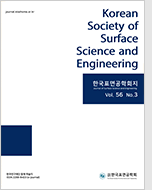
- Past Issues
- e-Submission
-

2021 Impact Factor 1.766
5-Year Impact Factor 1.674
Editorial Office
- +82-2-563-0935
- +82-2-558-2230
- submission@kssse.or.kr
- https://www.kssse.or.kr/

2021 Impact Factor 1.766
5-Year Impact Factor 1.674
The Korean Society of Surface Science and Engineering 2023;56(1):104-114. Published online: Feb, 28, 2023
DOI : 10.5695/JSSE.2023.56.1.104
Three dimensional (3D) porous structures consisting of Cu@CoO core-shell-type nano-dendrites were synthesized and tested as the anode materials in lithium secondary batteries. For this purpose, first, the 3D porous films comprising Cu@Co core-shell-type nano-dendrites with various thicknesses were fabricated through the electrochemical co-deposition of Cu and Co. Then the Co shells were selectively anodized to form Co hydroxides, which was finally dehydrated to get Cu@CoO nano-dendrites. The resulting electrodes exhibited very high reversible specific capacity almost 1.4~2.4 times the theoretical capacity of commercial graphite, and excellent capacity retention (~90%@50th cycle) as compared with those of the existing transition metal oxides. From the analysis of the cumulative irreversible capacity and morphology change during charge/discharge cycling, it proved that the excellent capacity retention was attributed to the unique structural feature of our core-shell structure where only the thin CoO shell participates in the lithium storage. In addition, our electrodes showed a superb rate performance (70.5%@10.8 C-rate), most likely due to the open porous structure of 3D films, large surface area thanks to the dendritic structure, and fast electron transport through Cu core network.
Keywords Cobalt oxide; Core-shell; Dendrite; Anode; Lithium battery.